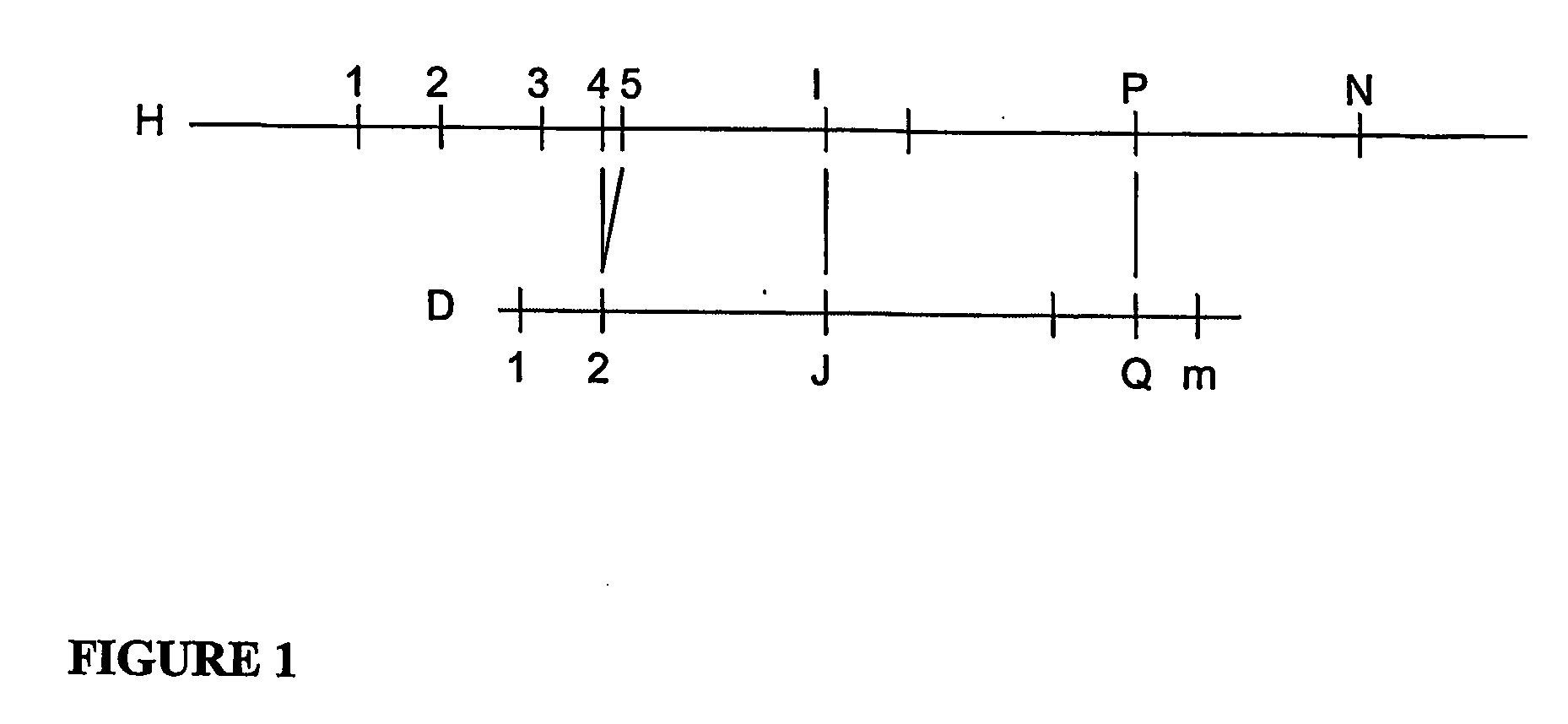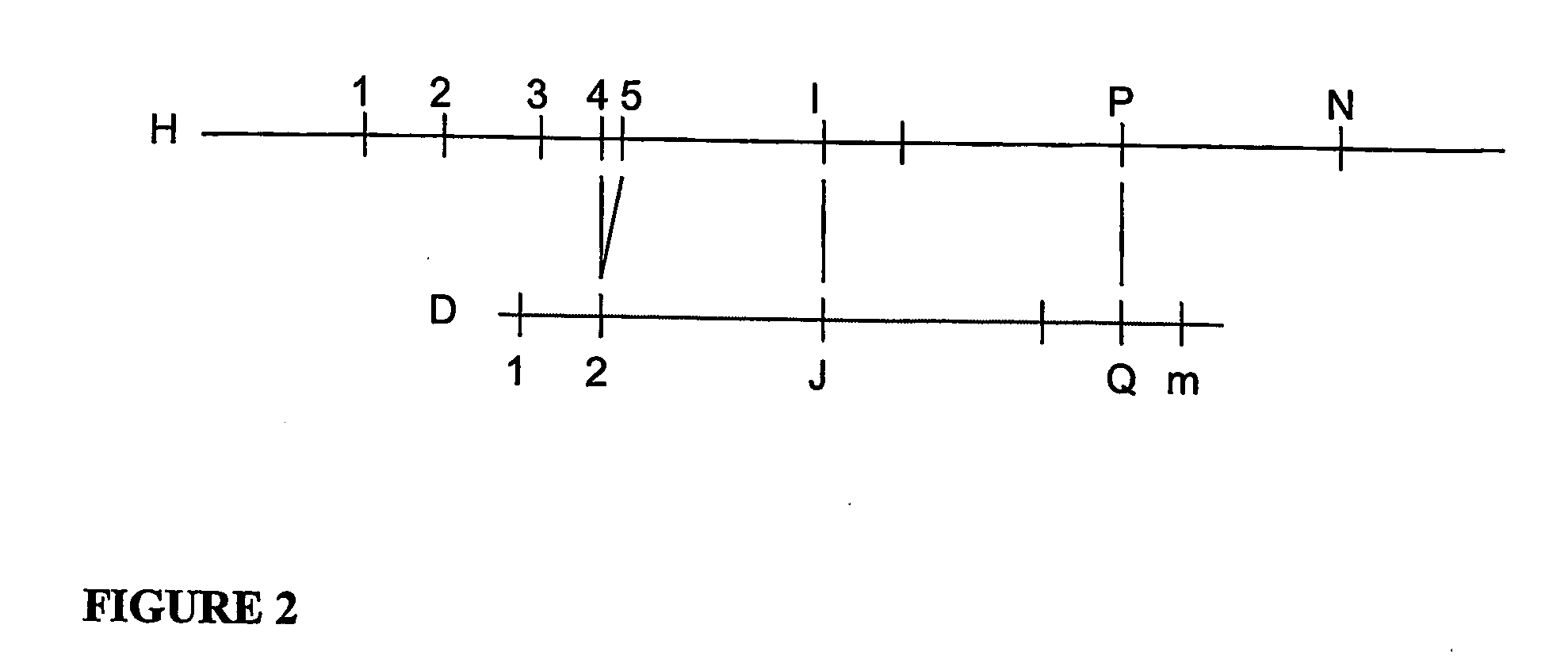System, Process And Software Arrangement For Disease Detection Using Genome Wide Haplotype Maps
a technology of genome wide haplotype and software arrangement, applied in the field of systems, process and software arrangement for producing genome wide haplotype maps, can solve problems such as failure of restriction enzymes, errors can be introduced, and non-uniform staining
- Summary
- Abstract
- Description
- Claims
- Application Information
AI Technical Summary
Benefits of technology
Problems solved by technology
Method used
Image
Examples
example 1
[0051]According to a process according to one exemplary embodiment of the present invention will now be described, an alignment probability expressions is provided that correspond to a good error model for Optical Mapping data:
FAI,J,P,Q≡λQ-J-1(1-Pd)P-I-1PdG(DQ-DJ,HP-HI)(1-PvHP-HI)(0.7)FMI,P≡PvHP-HI(0.8)URI,J≡{∑P=I+1N+1FRI,J,P,P-1,IfJ≤mPvHN+1-HN+Re(PvHN+1-HN-1) / logPv,IfI=NandJ=m+10,otherwise(0.9)ULI,J≡{∑P=0I-1FLI,J,P,P+1,IfJ>0PvH1+Re(PvH1-1) / logPv,IfI=1andJ=00,otherwiseWhere,FRI,J,P,Q≡λm-J(1-Pd)P-I-1(1-PvHp-HI)(ReGE(Dm+1-DJ,HP-HI,HP-HQ)+(P>N?1:0)G(Dm+1-DJ,HN+1-HI))FLI,J,P,Q≡λJ-1(1-Pd)I-P-1(1-PvHI-HP)(ReGE(DJ,HI-HP,HQ-HP)+(P=0?1:0)G(DJ,HI))G(d,h)≡-(d-h)2 / 2σ2h2πσ2hGE(d,h,b)≅12{erf(d-h+bσ2max(h-b,min(d,h)))+erf(h-dσ2max(h-b,min(d,h)))}
[0052]Where Pd is the digest rate, and hence (1−Pd) is the missing restriction site rate, λ is the false-positive site rate (sites per Mega base for example), σ2h is the Gaussian sizing error variance for a fragment of size h, and Pv is the probabili...
example 2
[0071]An application of one exemplary embodiment of the present invention to a simulated data set is described below. For this exemplary embodiment, the basic map assembly algorithms is preferably extended by adding a post processing phase to carefully examine the component input maps that go into each consensus map, assign each input map to one of two populations and reassemble them into two separate consensus maps. This implementation uses simulated data to allow the performance for data error rates greater than present in actual data to be determined.
[0072]To generate simulated data the first 5 megabases of human chromosome 21 published by NIH can be used, and an in-silico restriction map may be generated for the restriction enzyme PacI, and then random errors are repeatedly introduced into this restriction map using the error rates described above and selected a random piece of between 1.5 and 2.5 Megabases. This set of simulated data can represents one parental copy of chromoso...
PUM
 Login to View More
Login to View More Abstract
Description
Claims
Application Information
 Login to View More
Login to View More - R&D
- Intellectual Property
- Life Sciences
- Materials
- Tech Scout
- Unparalleled Data Quality
- Higher Quality Content
- 60% Fewer Hallucinations
Browse by: Latest US Patents, China's latest patents, Technical Efficacy Thesaurus, Application Domain, Technology Topic, Popular Technical Reports.
© 2025 PatSnap. All rights reserved.Legal|Privacy policy|Modern Slavery Act Transparency Statement|Sitemap|About US| Contact US: help@patsnap.com



